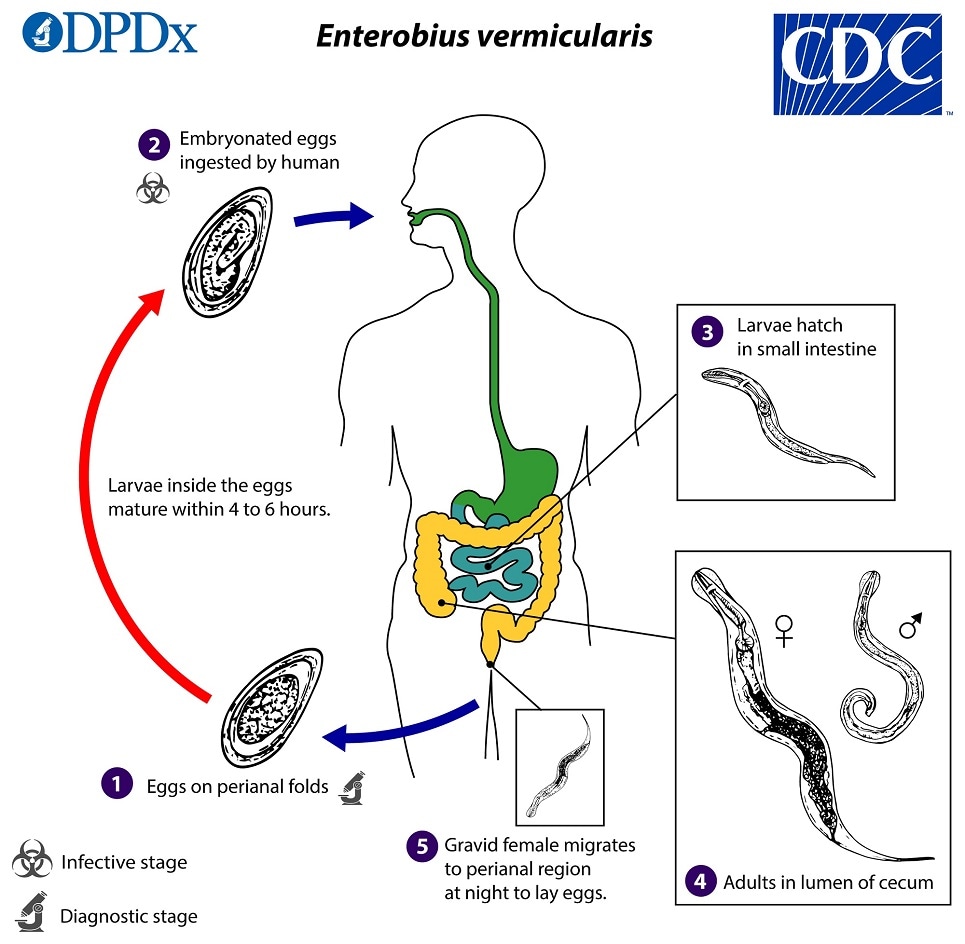
Enterobiasis
[Enterobius vermicularis]
Causal Agent
The nematode (roundworm) Enterobius vermicularis is widely known as the human pinworm due to the female’s long, pointed tail. In some areas the common names “seatworm” and “threadworm” are used (the latter of which is sometimes also used to refer to Strongyloides stercoralis). Another putative pinworm species, Enterobius gregorii, has been described and reported from humans in Europe, Africa, and Asia. However, further morphologic and molecular evidence suggests E. gregorii likely represents an immature form of E. vermicularis. The rat pinworm, Syphacia obvelata, has also very rarely been reported infecting humans.
Life Cycle
Gravid adult female Enterobius vermicularis deposit eggs on perianal folds  . Infection occurs via self-inoculation (transferring eggs to the mouth with hands that have scratched the perianal area) or through exposure to eggs in the environment (e.g. contaminated surfaces, clothes, bed linens, etc.)
. Infection occurs via self-inoculation (transferring eggs to the mouth with hands that have scratched the perianal area) or through exposure to eggs in the environment (e.g. contaminated surfaces, clothes, bed linens, etc.)  . Following ingestion of infective eggs, the larvae hatch in the small intestine
. Following ingestion of infective eggs, the larvae hatch in the small intestine  and the adults establish themselves in the colon, usually in the cecum
and the adults establish themselves in the colon, usually in the cecum  . The time interval from ingestion of infective eggs to oviposition by the adult females is about one month. At full maturity adult females measure 8 to 13 mm, and adult males 2 to 5 mm; the adult life span is about two months. Gravid females migrate nocturnally outside the anus and oviposit while crawling on the skin of the perianal area
. The time interval from ingestion of infective eggs to oviposition by the adult females is about one month. At full maturity adult females measure 8 to 13 mm, and adult males 2 to 5 mm; the adult life span is about two months. Gravid females migrate nocturnally outside the anus and oviposit while crawling on the skin of the perianal area  . The larvae contained inside the eggs develop (the eggs become infective) in 4 to 6 hours under optimal conditions
. The larvae contained inside the eggs develop (the eggs become infective) in 4 to 6 hours under optimal conditions  .
.
Rarely, eggs may become airborne and be inhaled and swallowed. Retroinfection, or the migration of newly hatched larvae from the anal skin back into the rectum, may occur but the frequency with which this happens is unknown.
Hosts
Oxyurid nematodes (pinworms) generally exhibit high host specificity. Humans are considered the only host for E. vermicularis, although occasional infections have been reported in captive chimpanzees.
Geographic Distribution
E. vermicularis occurs worldwide, with infections occurring most frequently in school- or preschool-children and in crowded conditions.
Clinical Presentation
Enterobiasis is frequently asymptomatic. The most typical symptom is perianal pruritus, especially at night, which may lead to excoriations and bacterial superinfection. Occasionally, invasion of the female genital tract with vulvovaginitis and pelvic or peritoneal granulomas can occur. Other symptoms include, teeth grinding, enuresia, insomnia, anorexia, irritability, and abdominal pain, which can mimic appendicitis. E. vermicularis larvae are often found within the appendix on appendectomy, but the role of this nematode in appendicitis remains controversial. Very rare instances of eosinophilic colitis associated with E. vermicularis larvae have been reported.
The eggs of Enterobius vermicularis measure 50—60 µm by 20—30 µm. They are transparent, elongate to oval in shape, and slightly flattened on one side. They are usually partially embryonated when shed. Enterobiasis can be diagnosed by applying cellulose tape to the anus of a suspect patient, especially in the morning before the patient’s first bowel movement. Eggs will adhere to the tape and can be seen microscopically.
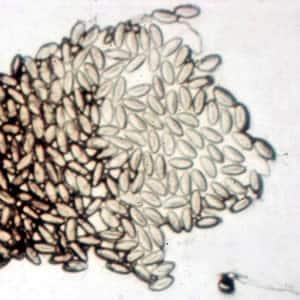
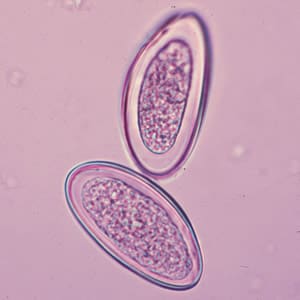
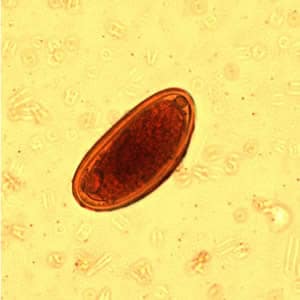
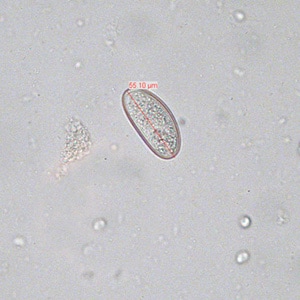
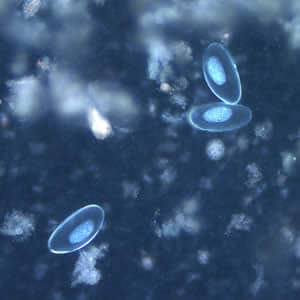
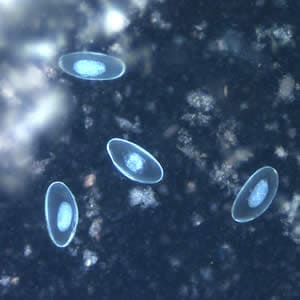
Adult males of Enterobius vermicularis measure up to 2.5 mm long by 0.1-0.2 mm wide; adult females measure 8-13 mm long by 0.3-0.5 mm wide. Adult males have a blunt posterior end with a single spicule; females possess a long pointed tail. In both sexes, there are cephalic expansions.
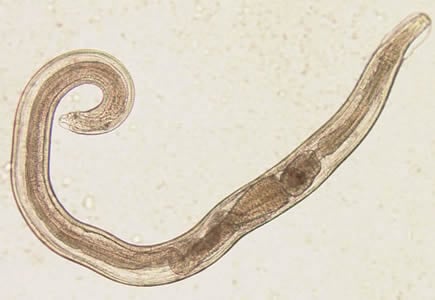
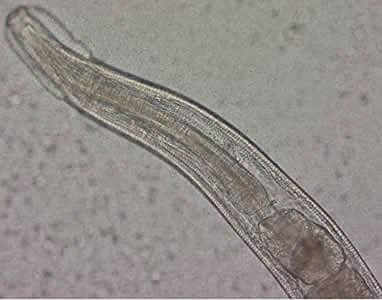
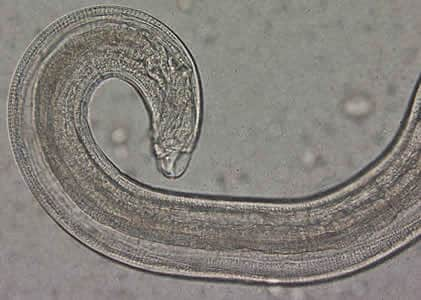
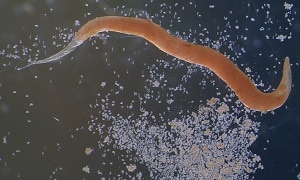
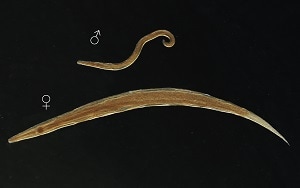
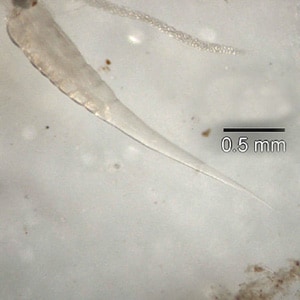
Adult males of Enterobius vermicularis measure up to 2.5 mm long by 0.1—0.2 mm wide; adult females measure 8—13 mm long by 0.3-0.5 mm wide. Adult males have a blunt posterior end with a single spicule; females possess a long pointed tail. In both sexes, there are cephalic expansions.
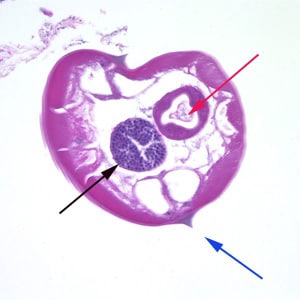
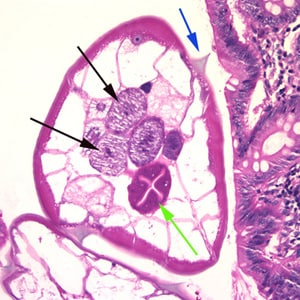
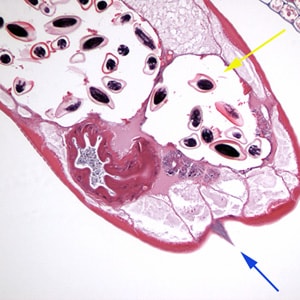
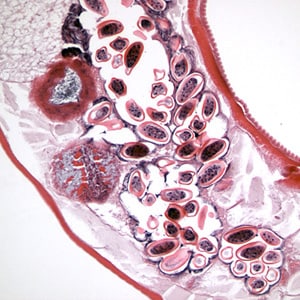
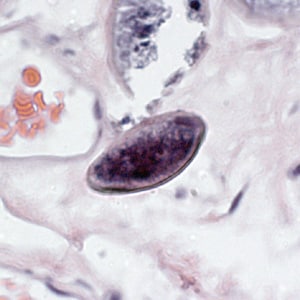
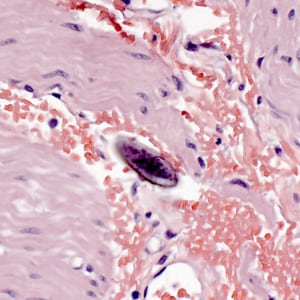
Laboratory Diagnosis
Microscopic identification of eggs collected in the perianal area is the method of choice for diagnosing enterobiasis. To improve sensitivity, collection should be done in the morning, before defecation and washing, by pressing transparent cellulose tape (“Scotch test”, cellulose tape slide test) on the perianal skin and then examining the tape placed on a microscope slide. Alternatively, anal swabs or “Swube tubes” (a paddle coated with adhesive material) can also be used for collection. Eggs can also be found, but less frequently, in the stool, and occasionally are encountered in the urine or vaginal smears. Adult worms are also diagnostic, when found in the perianal area, or during anorectal or vaginal examinations. In cases of ectopic infection, eggs may be seen in the urine or in cervicovaginal Papanicolaou smears.
More on: Morphologic comparison with other intestinal parasites.
Laboratory Safety
Standard precautions apply for processing stool samples (also tape test samples) to avoid accidental ingestion of infectious eggs. Surfaces should be cleaned thoroughly as the outer coat of E. vermicularis eggs is adhesive.
Suggested Reading
Peixoto, A., Gonçalves, R., Silva, M., Gaspar, R., Silva, R., Portugal, R. and Macedo, G., 2016. Eosinophilic ileocolitis due to Enterobius vermicularis infection: a rare cause of anemia. International Journal of Colorectal Disease, 31(3), pp.743-743.
Hasegawa, H., Takao, Y., Nakao, M., Fukuma, T., Tsuruta, O. and Ide, K., 1998. Is Enterobius gregorii Hugot, 1983 (Nematoda: Oxyuridae) a distinct species? The Journal of parasitology 84, pp.131-134.
Cook, G.C. 1994. Enterobius vermicularis infection. Gut. 35, pp. 1159-62.
DPDx is an educational resource designed for health professionals and laboratory scientists. For an overview including prevention, control, and treatment visit www.cdc.gov/parasites/.
